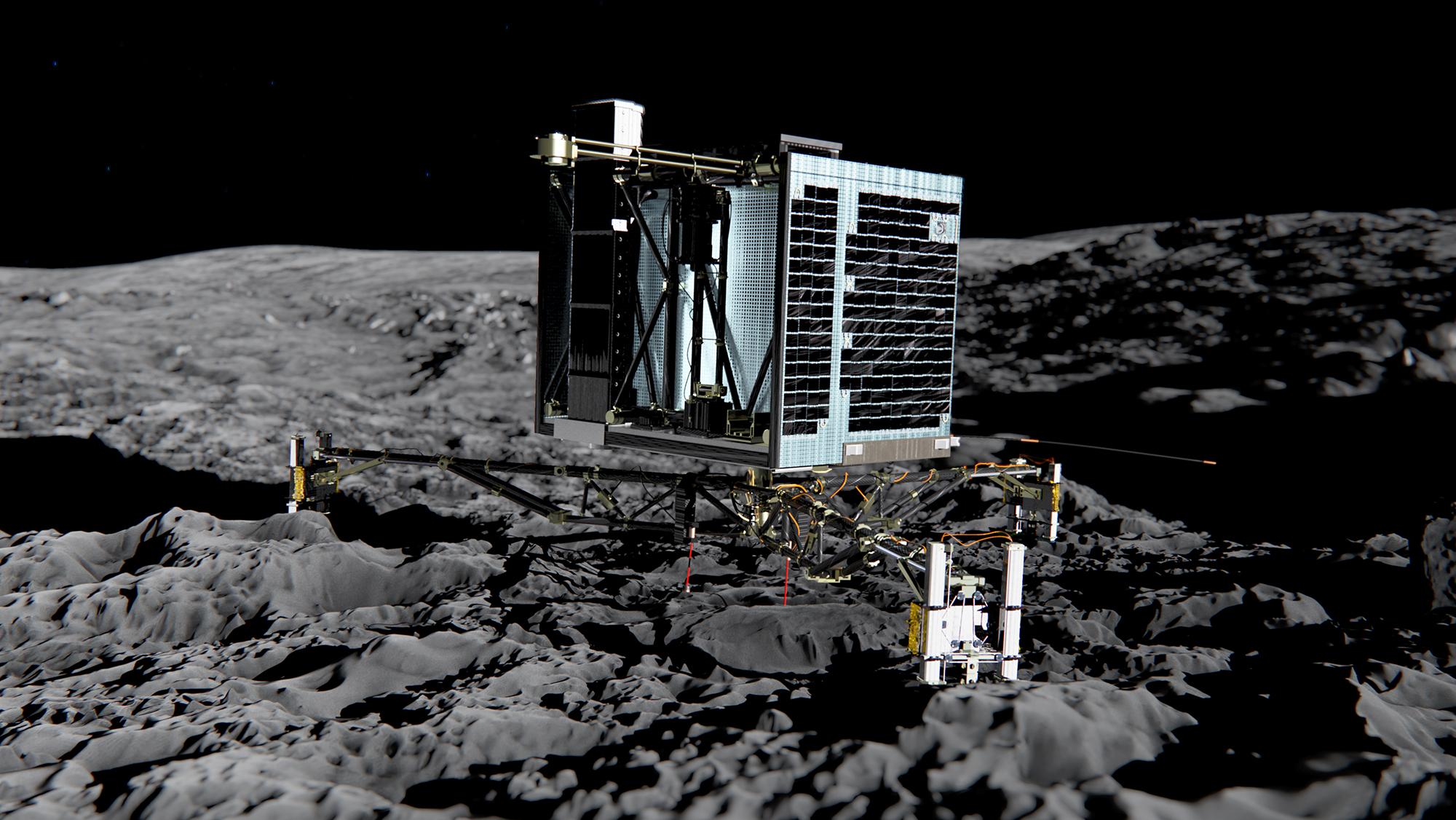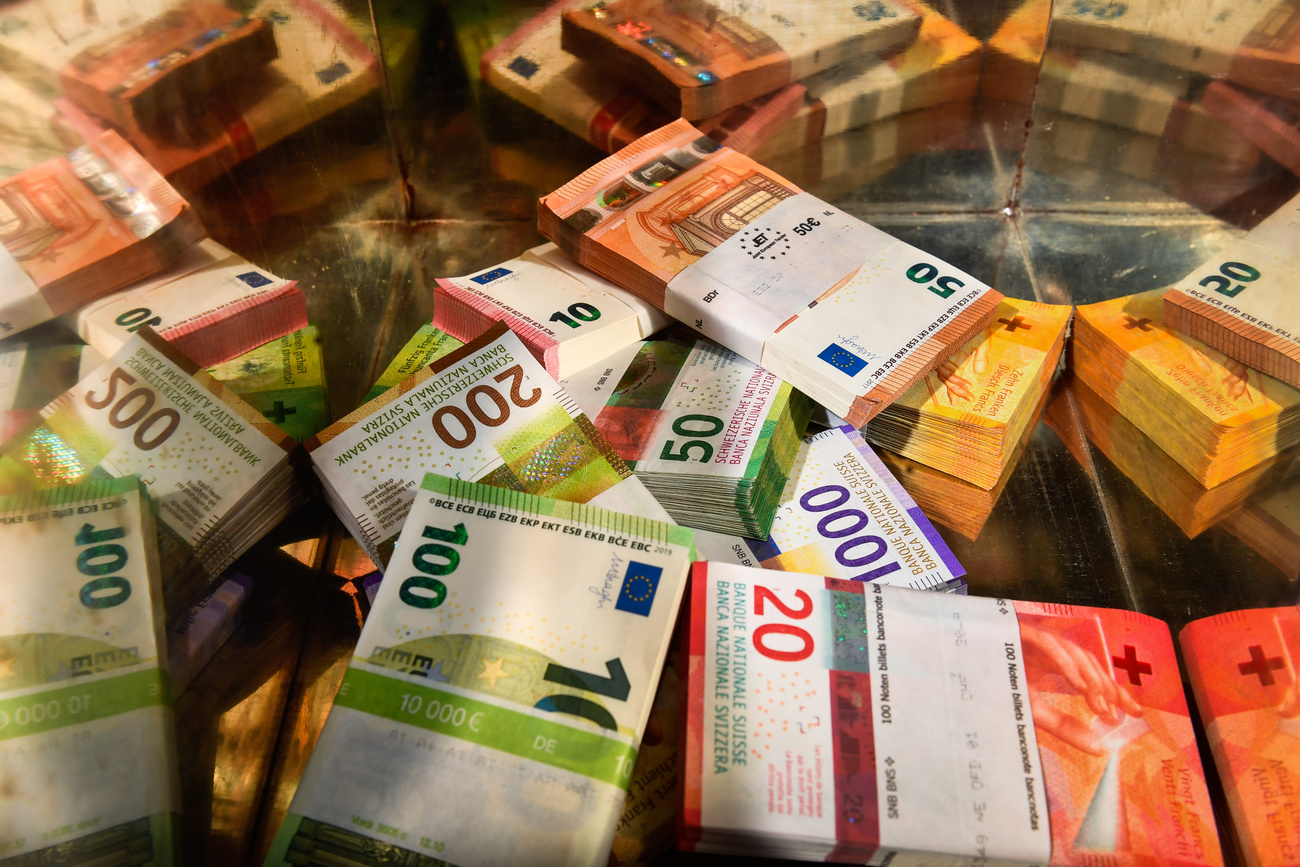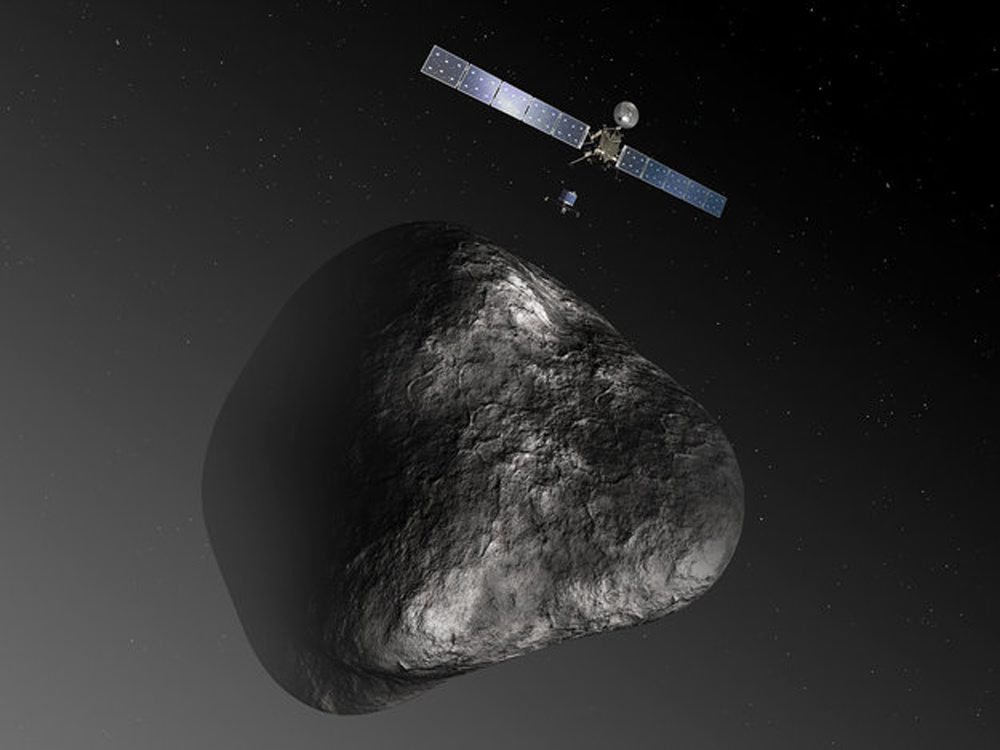Comet landing could unlock the secret to life

Europe’s space programme is preparing for a premier: landing a robot on a comet’s surface. And some of the mysteries it holds are being deciphered in Bern.
“Comets resemble the first elements which merged to create planets. At least, that’s what we have strong reason to believe,” explains Kathrin Altwegg, cosmic chemistry specialist at the University of Bern and the principal investigator behind the European Space Agency’s ROSINA experiment.
In August, ten years after its launch on March 2, 2004, the Rosetta space probe – with ROSINA on board – finally reached its destination: the comet named 67P/Churyumov-Gerasimenko, or “Chury” for short.
ROSINA is the heaviest scientific instrument aboard Rosetta and will analyse matter and gases evaporating from the comet into space. Developed under the University of Bern’s direction, it consists of two mass spectrometers and a pressure sensor.
And on November 12, if all goes well, Rosetta’s lander will touch down on Chury as the first spacecraft ever to land on a comet.
A long – and looping – journey
Chury lies some 400 million kilometres from Earth. To get there, Rosetta had to travel six billion kilometres, orbiting the Sun four times, swinging past the Earth three times and looping once around Mars. Those manoeuvres helped it benefit from a “slingshot” effect to gain acceleration. But once Rosetta met with Chury’s trajectory, its engines had to slow it down to avoid missing the rendezvous with the comet.
“When we saw the comet’s signal, it was fascinating,” Altwegg says. “We had to slow the speed down by 24,000 kilometres an hour, and locate a four-kilometre object within the vastness of the solar system. It was a great success.”
Now, scientists are eagerly anticipating what secrets a landing on Chury could unlock about the history of our planet – and the universe.
Earth’s source of water
Earth is believed to have had a lot of water at first. But during its formation, when the planet resembled a melting sphere of lava, extreme heat caused the original water to evaporate into space.
So how did water return to Earth? Comets could hold the key.
Often dubbed “big dirty snowballs”, comets contain up to 50% water, with the rest made up of fine dust. When comets travel through the frozen confines of the solar system, the water remains in a solid state. As they approach the sun, heat causes the water to evaporate and to disperse the dust, creating the comet’s impressive tail which may extend for millions of kilometres. That’s the tail we see from Earth, which often aroused fear in ancient cultures.
“The [current] theory says that 800 million years after their formation, planets experienced a massive bombardment by smaller celestial bodies, including asteroids and comets,” Altwegg explains. “If we look at the age of the moon’s craters, we can see that they all appeared around 3.8 million years ago.”
On Earth, because of erosion, the signs of such celestial bombardment have almost all disappeared. But water from comets may have been what filled the oceans. It’s no surprise that these planetary “building blocks” contain so much water, since water seems to be abundant in the universe.
Signs of life
Comets may have left more than just water on Earth; in fact, scientists believe they also contain pre-organic molecules, critical to the development of life. As its name suggests, the Rosetta mission aims to decipher whether life’s building blocks originated from space: its name comes from the Rosetta stone, used by the 19th Century scholar Jean-François Champollion to decode hieroglyphs from Ancient Egypt.
But Altwegg says ROSINA’s findings so far are just at the beginning of decoding possible signs of life.
“This is not yet life,” she specifies. “They are molecules such as amino acids, whose presence would explain how life appeared so quickly after the comet bombardment, some 100 million years later – almost no time at all in the grand scheme of the universe.”
Surprising pictures – and smells
Since the August rendezvous with Chury, images sent from Rosetta have astonished viewers on Earth. Instead of the potato-shaped core that scientists expected, the comet has more of a duck-like form. Scientists expect that when Chury passes closer to the sun’s heat, its neck will melt and split it in half.

More
The trip: Unbelievable precision, astounding images
And the comet holds other surprises. Since Rosetta started orbiting it, ROSINA has already sent back lots of information about its composition – and its less-than-appealing smell.
“We have observed loads of different molecules, including some which have never been observed on a comet,” Altwegg says. “The combination of these suggests that Chury stinks of rotten egg, due to the presence of hydrogen sulfide, together with other unpleasant scents, such as ammonia.”
“There is also a high number of pre-organic molecules, and they have not all yet been identified,” Altwegg adds. She expects it will take a long time before they – and all of ROSINA’s other data – are analysed.
“ROSINA sends us data every day. In 1986, when the Giotto probe passed close to Halley’s comet for an hour and a half, at 70 times the speed of a bullet, it took us ten years to analyse the data.”
Like a feather, landing with a harpoon
If Rosetta succeeds in landing a small robot onto the comet’s surface on November 12, researchers will have even more data to process. On that day, at 0835 GMT, the lander called Philae will begin a seven-hour descent onto Chury’s surface. The operation will be extremely delicate, especially since it has never been attempted before.
Due to minimal gravity on the comet, Philae will weigh barely a gram. So there’s a risk that the lander could bounce back into space or that the comet could spew gases on it, blowing it away like a feather. To avoid this, the lander is equipped with harpoons that will tether it to the surface of the comet – provided a solid surface can be found.
“A comet is not really solid ice. It’s lots of nothing… 70% emptiness,” Altwegg explains. “It is like very, very powdery snow, and you know what happens in powder”.
The mission’s designers will rejoice at a successful landing while scientists will be curious to see samples taken from the comet’s surface.
But even if all goes as planned, Kathrin Altwegg admits the mission is “useless” to humanity, beyond feeding our thirst for knowledge.
“No one will have more to eat, and we will not resolve an ecological problem,” she says. “It is just a fundamental question for humanity. We would like to know whether comets brought water, as well as organic molecules, to Earth, which would explain why everything developed so rapidly.”
“That brings us to the question: Are we alone in the universe?”
ROSINA (or Rosetta Orbiter Spectrometer for Ion and Neutral Analysis), weighs 35 kilos, or 20% of the Rosetta probe’s payload. The instrument is made up of two mass spectrometers that can detect and identify molecules according to their mass. It also has a pressure sensor that has already begun sending information about the composition of the comet’s tail.
The device was developed and constructed by an international consortium under the direction of the Physics Institute at the University of Bern. Seven cameras on board the lander, Philae, provide panoramic vision and have already captured stunning images. These include “selfies” of the probe with Mars and the comet in the background.
Space-X, a Neuchâtel-based firm, as well as the French Institut Astrophysique Spatiale and the Centre National d’Etudes Spatiales were responsible for the cameras’ design and construction.
(Adapted from French by Paula Dupraz-Dobias)

In compliance with the JTI standards
More: SWI swissinfo.ch certified by the Journalism Trust Initiative












You can find an overview of ongoing debates with our journalists here . Please join us!
If you want to start a conversation about a topic raised in this article or want to report factual errors, email us at english@swissinfo.ch.